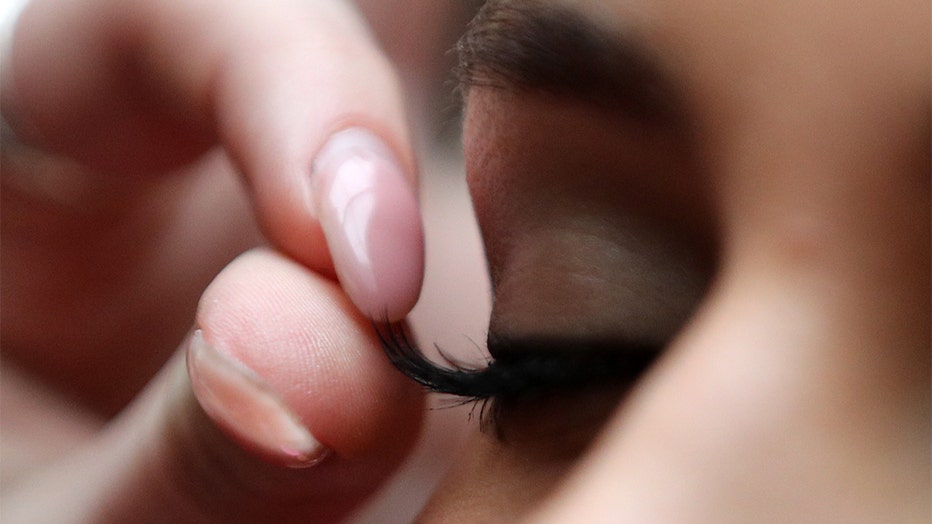Amid popularity of eyelash extensions, some doctors see uptick in lash mites due to poor hygiene

Amid popularity of eyelash extensions, some doctors see uptick in lash mites due to poor hygiene
As eyelash extensions become a popular trend, some doctors say they are seeing an uptick in lash mites due to poor hygiene.
LOS ANGELES - As eyelash extensions become a popular trend, some doctors say they are seeing an uptick in lash mites due to poor hygiene.
Dr. Sairah Malik, an optometrist in Houston, said she’s seen an increase in Demodex, which is the medical term for the mites.
“This is due to the fact that a lot of people who get extensions are afraid to wash their eyes and eyelashes due to the fact that they may damage the extensions which are costly and time consuming. As a result of not washing, this area becomes a breeding ground for bacteria and other parasites such as the Demodex,” Malik said.
Demodex is a genus of tiny parasitic mites that live in or near hair follicles of mammals, according to an article from the Indian Journal of Dermatology, published on the National Institutes of Health.

FILE: A woman touches up her makeup. (Photo by Sergei BobylevTASS via Getty Images)
“Demodex is a parasite that lives inside the hair follicle, so naturally anywhere there is a hair follicle, Demodex can survive there, as long as there is enough food/bacteria for it to thrive in,” Malik added.
“The eyelash extensions act as a sort of sponge for bacterial buildup which is an ideal environment for Demodex to thrive,” said Dr. Kam Silani, an optometrist in Beverly Hills, California, who said he has also seen cases of the mites.
He said there seems to be an increase in the number of diagnosed case of Blepharitis (inflammation of the eyelids) among his patient population. Two main contributors to anterior Blepharitis are bacterial overgrowth and Demodex.
“Demodex has a classical presentation known as cylindrical dandruff which resides at the base of the eyelashes,” Silani said, adding that the terms eyelash “mites” and “lice” are sometimes used interchangeably, but refer to the same organism — Demodex.
Malik said the technical term for the eyelash mites is Demodex, but it is similar to lice.
Janet Figueroa, a cosmetologist and owner of Kiss My Lash in Ontario, California, said the reason people often cite for not washing their eyelash extensions is a myth.
“There is an increase in women thinking if they don’t wash them they’ll fall out faster but that’s just a bad myth, they only fall out of the technician doesn’t apply then properly,” Figueroa said.
But she said she doesn’t see the mites with her clients because she does proper after-care education with them.
“New clients don’t come in with this, the only times I have seen it it started with my clients admitting that they don’t wash them, and as they come in for a fill you notice gunk (yellow/flesh colored) build up of old cells or makeup. After that it becomes these yellow bulb like bumps on the lashes at the base of the natural lash and then that grows into the lash mites,” the cosmetologist said.
Silani also said she has encountered patients who avoid washing their eyelash extensions.
“Demodex live dormant on skin, when there’s an imbalance or overgrowth then they can cause various issues and symptoms for the patient(s). Unfortunately many of these women with false lashes avoid washing their eyelashes because they are worried that they may ruin the extensions; thus, creating an ideal environment for Demodex to flourish.”
Malik also said it’s important to ask one’s eyelash facility to demonstrate the proper way to clean the extensions.
“We see a very young population and in our age demographic, eyelash extensions are very popular and common. So we see many many cases in a month and treat this (Demodex) on a very regular basis,” the optometrist said.
Malik wanted to be clear that eyelash extensions do not cause Demodex.
“The lack of hygiene and proper maintenance of the extensions is what leads to this condition. We must also note that individuals who do not get extensions and also do not wash or cleanse their eyelash margins appropriately are at risk as well,” she said.
Malik said she has seen Demodex cases with patients who don’t have eyelash extensions, particularly in men.
“We have observed many cases of Demodex in those individuals without eye lash extensions. For example, we have seen this condition in a lot of men due to the fact that most only use soap and water to wash their face,” she said. “Most women pay more attention to cleansing due to removing eye make up, etc., so we have to educate the men, that they must cleanse their eyes and eyelashes to keep the bacterial load down which naturally increases with age.”
“The frequency with which we diagnose Demodex seems to be on the rise among male patients who don’t have good eyelid hygiene techniques as well as women with eyelash extensions,“ Silani added.
The optometrist also warned against using oil-based cosmetics, saying "instead we support the use of water-based makeup."
"Ideally, treatment with in-office device, BlephEx, in combination with at-home, diluted tea tree oil, such as Ocusoft Demodex wipes or foam, work best to eradicate the mites,” he said.

